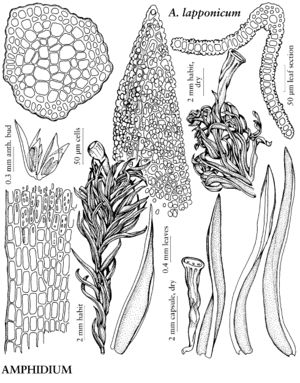Difference between revisions of "Amphidium lapponicum"
Coroll. Bryol. Eur., 39. 1856.
FNA>Volume Importer |
FNA>Volume Importer |
(No difference)
| |
Revision as of 19:45, 24 September 2019
Plants 0.5–3.5 cm. Stem leaves ligulate-lanceolate, 2–3 mm; margins plane, entire; basal laminal cells clear, walls firm; distal cells 8–11 µm, obscured by papillae, papillae warty, relatively large. Sexual condition autoicous; perichaetial leaves erect, enlarged, base sheathing, apex short-pointed. Seta 1–1.5 mm. Capsule immersed to 1/2 emergent, 0.8–1.3 mm; operculum short-rostrate, less than diam. of capsule. Spores 9–13 µm.
Habitat: Seasonal wet crevices of neutral to acidic cliffs
Elevation: low to high elevations
Distribution
Greenland, Alta., B.C., N.B., Nfld. and Labr., N.W.T., N.S., Nunavut, Ont., Que., Sask., Yukon, Ala., Ariz., Calif., Colo., Conn., Idaho, Maine, Md., Mich., Minn., Mont., Nev., N.H., N.J., N.Y., Oreg., Pa., Vt., Va., Wash., Wis., Wyo., Europe, Asia.
Discussion
Amphidium lapponicum differs from the two other North American species by its broader leaves and larger, warty, cuticular papillae that obscure the distal laminal cells. The species is autoicous and frequently fruiting, in which case the immersed to emergent capsules serve to identify it. Additionally, the larger laminal cells (8–11 µm) differentiate this species from the other entire-margined species, A. mougeotii, which has smaller distal laminal cells (5–9 µm).
Selected References
None.
